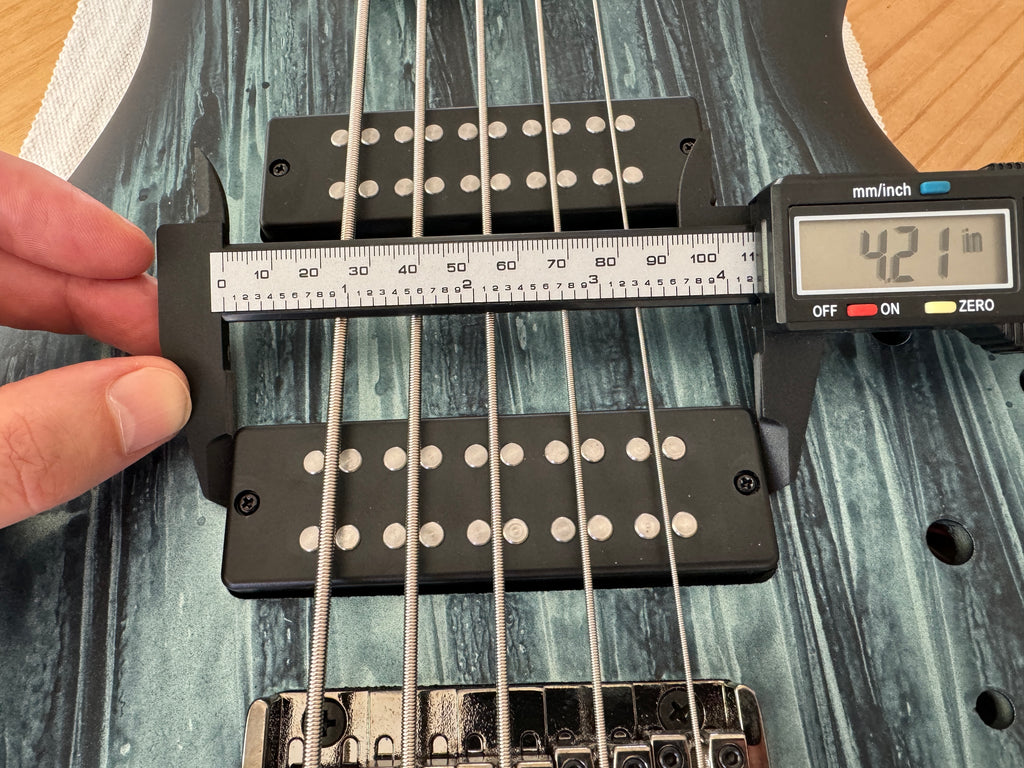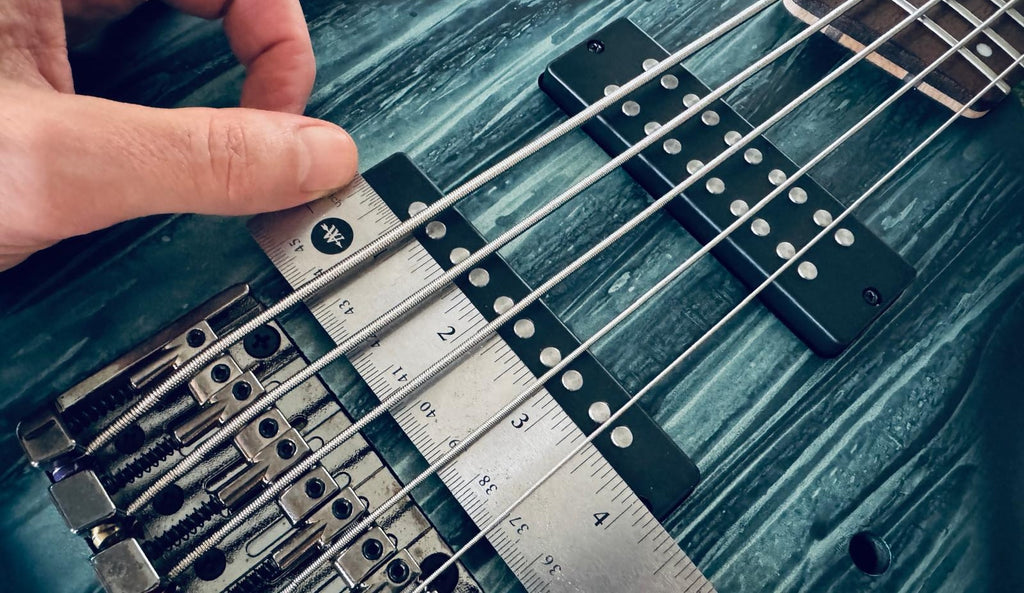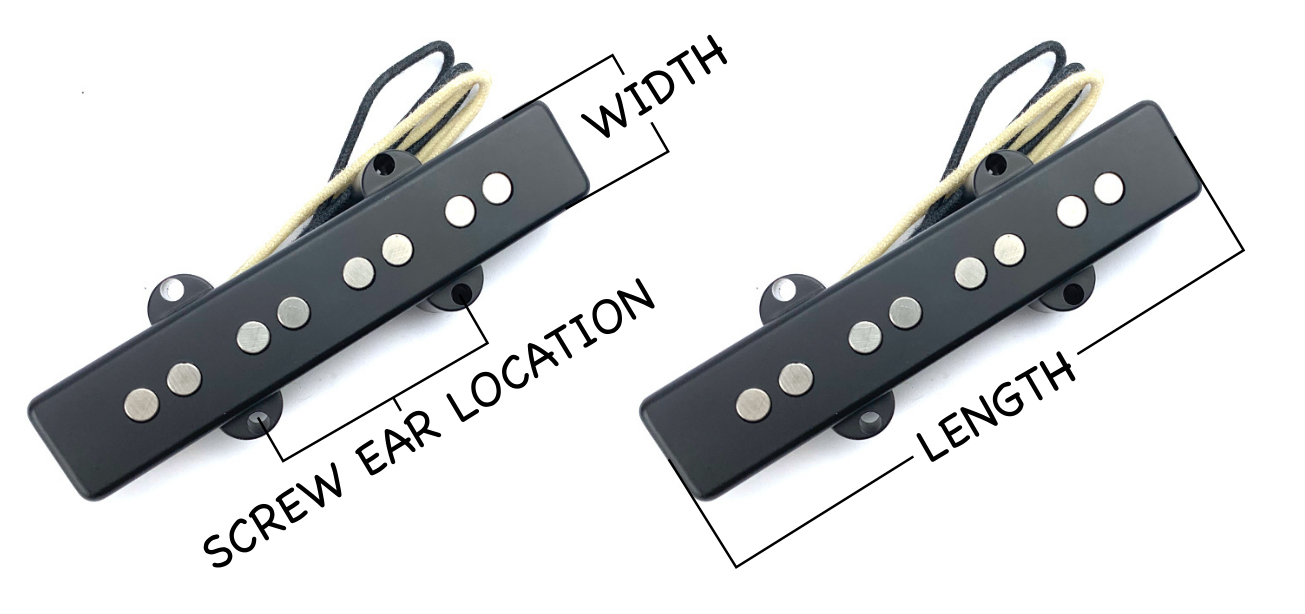The origin of the 5-string bass with a low B string can be traced back to boutique builders of the 70s who were looking for new ways to expand the voice of the electric bass.
The concept caught on, and by the mid-80s, several large manufacturers went with the concept and added several 5-string models to their product lines. Since then, the 5-string bass has continued to find a place in the hands of bass players all over the world.
However, comparatively speaking, a larger number of electric basses have 4 strings, which meant that most aftermarket pickups, as well as other parts, weren't available in 5 string versions.
But over the past three decades, we’ve seen more and more manufacturers embracing the 5-string and offering extended-range versions of their product lines.
In this article, we’ll give you an overview of the pickups that are available for your 5-string bass, and the sizing / measurements you need to take to get the right pickups... should you decide to explore new sonic territory with it.
First, measure carefully
Not all pickup routes are created the same. Unlike our guitar-playing friends, bass is a lot less homogenized. This means you may come across basses not routed for standard sized pickups. You DEFINITELY want to measure your pickups before purchasing. Measure twice, buy once :)
To help make this process easier, we have detailed measurements of every pickup we carry on its product page.
Additionally, if you use the filtering menu in the collections of the different pickup types, you will be able to filter for specific shapes/sizes.
How to measure your current pickups
There are a few ways to physically do the measurements of pickups. We will touch on three ways below to get an accurate measurement:
1. Micrometer
This is probably the quickest and most accurate for most people...if they have a micrometer on hand. A micrometer reaches around strings and pickups easily, and often provides a reading in both Imperial (inches) and Metric (millimeters) units.

2. Two Business cards and a ruler
A business card or other small straight-cut object works very well. Line up the business card along the sides of the pickup. Lay a ruler on top (or underneath), aligning a whole number with the inside edge of one of the business cards. In this case, because I was use a 15" ruler, I could line up one edge with the 10" mark. The other business card and ruler line up at just over the 14 3/16" mark. Subtracting the two, we get 4" and a heavy 3/16"...more precisely to 7/32" (I am splitting the difference between 3/16" and 1/4"). 7/32 = .22, so this measurement gives us a total width of 4.22". Imperial users may be persuaded to use the metric side of the ruler for quicker results :)

3. Ruler or tape measure on top of the pickups
While not as accurate for most folks, this will often get the job done if you use rulers/tape measures a lot. Simply lay the ruler/tap measure across the top of one of the pickups, lining one end up with the zero mark (or a reference number similar to my use of the 10" mark above). Typically, a ruler is going to be easier to slide under your strings. Most metal rulers have a cork or plastic backing to protect the surface on which the lie.

*A note on measurements that are 'pretty close'. Often pickups are slightly trapezoidal, meaning that the dimension at the bottom of the pickup cavity are slightly larger than at the top.
The key thing to check is if a stated pickup dimension from a manufacturer will fit in the cavity hole that you have.
In the examples above, the pickup in this Ibanez bass measures 4.21" at the locations where I measured it. The P2 shape is typically 4.25". This .04" is insubstantial in this case. We had no problem fitting in P2 shaped pickups from any manufacturer when fitting in the pickups. The route for the pickup is going to be larger to allow for insertion of the pickup without damage.
What measurements are important?
This depends a bit on the type of pickup(s) you have. Sometimes only the length is sufficient, sometime both length and width.
Let's breakdown the measurements needed by shape:
5 String Jazz Bass® Pickups - With J bass pickups, the width is standardized, so you really only need to measure the length of the pickup. A double check of the screw hole to screw hole size is also a nice confirmation.
In total, these come in 5 different combos/sizes, but the overwhelming majority fall into these 3 combos:
Fender American Standard®:
- Bridge Pickup ~4.12” (~104.6mm)
- Neck Pickup ~4.00” (101.5mm)
Non Fender® Long/Short:
- Bridge Pickup ~3.73” (94.7mm)
- Neck Pickup ~3.60” (91.4mm)
Non Fender® Long/Long:
- Bridge Pickup ~3.73” (94.7mm)
- Neck Pickup ~3.73” (94.7mm)

5 String P pickups are slightly more standardized. Like J bass pickups, widths are standardized, so only measuring the length is necessary. There really is just two versions of 5 String Ps. Fender sizing and most everything else. Fender sizing is usually referred to AS (American Standard) and the pickups are of two different lengths.
Fender American Standard® 5 String Precision Sizes:
- Shell closest to bridge ~3.2” (~81.3mm)
- Shell closest to neck ~2.6” (~66.0mm)
Nearly all other 5 String P pickups use the following:
- Both shells ~2.6” (~66.0mm)
5 String Soapbar Bass Pickups is where we get into a large variety. Soapbars require measuring both the length and width of the pickups. EMG and Bartolini have largely set the stage for the shapes as they were building 5 string pickups in the early days.
The most common sizes for retrofit are the following:
P2 ~4.25” (108mm) x 1.25" (31.75mm)
EMG40 ~4.0” (101.6mm) x 1.5” (38.1mm)
P4 ~4.65” (118.1mm) x 1.25”( 31.75mm)
MK ~4.26” (108mm) x 1.32” (33.5mm)
Many bass manufacturers (especially large companies having basses built in SE Asia) have created additional non-standard shapes that they use in their basses. These can be challenging and may require routing the body to replace pickups. Most of the boutique makers in North America and Europe are using one of the above mentioned sizes. Regardless, it is quite important to measure.
5 String MusicMan® Bass Pickups have 3 different shapes available, with the majority having one of the first two versions listed below. While it's true some of these do not have the classic MM screw 'ears', we still think of these basses as the MusicMan® style. Here is how we classify these shapes:
Ernie Ball® Stingray® ~4.38” (111mm) x 1.92” (49mm) - This model is most like a large soapbar shape, and does not have screw ears.
Lakland® / OLP ~4.14” (105mm) x 1.91” (49mm) - The largest of the shapes, looks like a long 4 string MM pickup. Measurements do not include the screw ears, but it does have screw ears sticking out.
Short ~3.5” (88mm) x 1.9” (48mm) - This size is the same as a 4 string MM pickup, measurements not including the screw ears.
Some sonic thoughts
Vintage voiced 5-string Pickups
A vintage 5-string bass? Although some might consider that an oxymoron, the reality is that many players want to get vintage vibes and enjoy their extended range. Luckily, some manufacturers found a way to super-size their vintage offerings to fit a larger fretboard and quench your thirst for vintage voiced mojo.
- Kloppman JB61-5: Kloppman is known for making some of the most accurate and best-sounding replicas of pickups from the 50s, 60s, and 70s. The JB61-5 captures all the mojo of its 4-string counterpart and manages to track the low B extremely well. So if you’re looking to infuse your 5-string J Bass with 60s vibes, these Kloppmanns are a fantastic option.
- Fralin 5 String J: The folks over at Fralin also managed to extend their 60s-inspired J Bass pickup to fit 5 strings. The tones are just about the same as the 4-string version and it keeps all the single coil dynamics, growl, and high-end presence that their J Bass pickups are known for.
- Nordstrand NP5V, NP5 and NP5F : Got a 5 string P Bass? The NP5V, NP5 and NP5F are Nordstrand’s vintage-voiced 5-string P Bass pickups. They have everything that you love about the 4-string versions but are made to accommodate the extra B string.
- Nordstrand MM5.2: These pickups were designed to capture the vibe of the 70s alnico-loaded MM pickup. It’s punchy, with a tight bottom, and the right amount of sizzle to cut through. If classic StingRay tones are your thing, then the MM5.2 could be what your 5-string needs.
New-Vintage 5-string pickups
This is where the options open up. Most 5-string bass players are open to getting some modern amenities in their mostly modern instrument. How about a bit of extra output? Or perhaps some hum-free tones? This is where you’ll get options that give you the classic tones without any of the vintage hassles.
- LeCompte Crooked J Bass: Do you have SoapBar pickups in your 5-string, but love the tone of a J Bass? LeCompte heard you and created the Crooked J Bass pickup. Why crooked? Because its magnets are at an angle. It looks cool IMO. This pickup will give you a convincing J Bass tone with no hum that will fit your SoapBar-equipped fiver.
- Sadowsky 5 String J and PJ: Sadowsky’s 5-string basses are what dreams are made of. But they do come with a hefty price tag, so if you’re looking for some of that Roger Sadowsky magic, you can get these pickups that he designed. They’re what you would call a tastefully hot-rodded version of a P and a J pickup.
- Delano J5TF: These pickups were designed to sound like the perfect jazz bass. They used an unusual kind of magnet called Toferrite and combined it with their uniquely fine-tuned wiring process. This gives these pickups added clarity, harmonic content, and dynamics. A good way to describe them is that they sound like someone has already taken them through the mastering process.
- Aguilar AG 5SSP-D2 Super Split: These are Aguilar’s take on the hum-canceling J Bass tone a SoapBar form factor. They have a healthy output but are still touch-sensitive. They sound like like a really big J Bass pickup. These pickups would be a great fit if you want the J Bass tone turned up to 11.
Modern 5-string pickups
For many, a 5 string bass is about exploring the extended range and extended tonal possibilities of your instrument. Here, you’ve got a wide range of options. You can go full-range and hi-fi, dynamic and punchy, or get a set of pickups that can do everything.
- LeCompte Triple Threat: These pickups have a unique three-magnet per string arrangement which gives them a cool look and a unique tone. They are designed to have a lot of harmonic content and clarity. If you value clarity, these are a great option.
- Seymour Duncan NYC 5 String: These pickups were originally designed for Fodera basses. They’re built like 2 J Bass pickups in one casing but have a very unique sound. They’re full range, dynamic, and punchy. Also, they can be wired in series, or parallel, and you can play with either coil of the pickup, which gives you some very convincing single-coil tones.
- Delano JMVC and PMVC: If you’re looking to modernize your P, J, or PJ-equipped bass, these Delano are worthy of your attention. To start, they look the part with their big exposed poles. Then they sound modern. Extra punch, faster, tighter lows, and a detailed high end are what these pickups will bring to the table.
- Nordstrand Big Blademan: This MM pickup was designed by Carey Nordstrand for Justin Chancellor of the band Tool. The goal was to have some of the clarity and unique mid-range from a Wal bass and combine with the growl and heft that are unique to Nordstrand. These do not sound like a classic MM pickup.
- Bartolini MV52CBJD3: this MM pickup is a quad coil design that can also be wired in series and parallel to give you a massive range of options. It has the classic Bartoline growl and warmth but gives you great flexibility due to all of its wiring options.
Take your 5-string bass tone anywhere you want it to go
The world of 5-string bass pickups has expanded significantly over the last decade, offering bass players a plethora of options to tailor their instrument's sound to their preferences.
Whether you're seeking vintage vibes, new-vintage tones, or modern sonic possibilities, there's a pickup out there for you.
Whichever path you choose, upgrading your 5-string bass with the right pickups opens up a world of sonic exploration and personalization.
And if you’re still on the fence trying to decide which pickup will take your 5-string bass in the direction of your unique low-end vision, give us a call and talk to a real human, or send us an email.
We’ve helped thousands of bass players find the perfect pickup for their bass, and we’re sure we can help you too.


